
Click less.
Engineer more.
Enrollment for
Python for Structural Engineers
is closed!Next chance to join: Q4 2025.
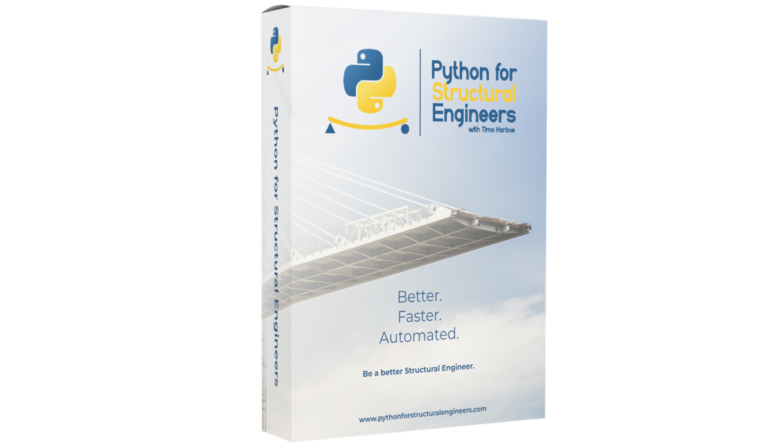
Learn with 400+ professionals from companies like
















No affiliation or endorsement implied.
Become a better engineer in 6 weeks
Get the most out of your computer. This course teaches Python, a straightforward programming language, for everyday structural engineering use.
- No programming experience required
- Learn to use AI as your engineering assistant
- Self paced - Take the time you need
- Integrate what you learn with the structural analysis software you already use - and Excel!
- Lifetime access*
- 100% Satisfaction Guarantee - 30 days refund!*
- Packed with tons of engineering examples
- * Terms and conditions apply
Faster
Free your time: Learn how to do batch calculations and build reusable calculation and finite element analysis postprocessing tools.
Better
Impress your clients: Create great looking outputs that are easy to understand and quality control. Even for people who are not familiar with code.
Automated
Don't repeat yourself: Set up workflows once, and adjust when needed.
Curriculum
Module 0
Day-to-Day Engineering Calculations
You’ll be guided through the basics of Python, from writing your first line of code to building digital tools that can handle most of your engineering calculations.
🎥 Example: Doing simple calculations with Python
🎥 Example: Working with units and hand calculations
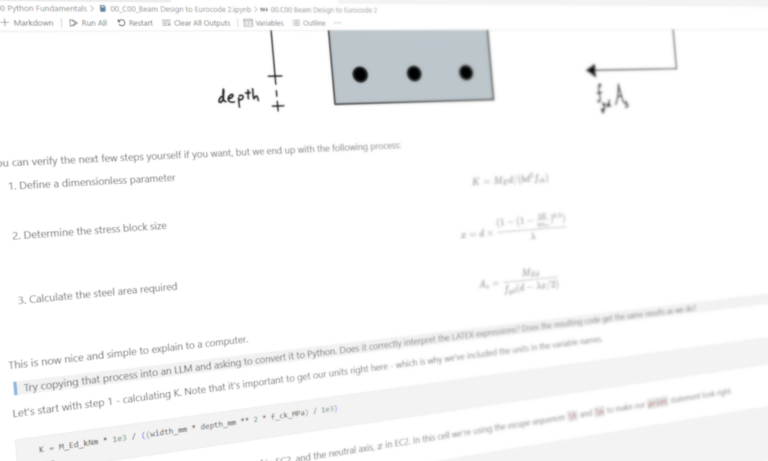
Module 1
Structural Analysis Plots – Better, Faster, Automated
We’ll dive into Matplotlib, a powerful plotting library in Python. We’ll explore examples like pile capacity plots, sensitivity analysis, and material quantity/cost plots. By the end, you’ll be able to create clear, professional plots for any engineering calculation.
You’ll be guided through the basics of Python, from writing your first line of code to building digital tools that can handle most of your engineering calculations.
🎥 Example: Plotting with Python
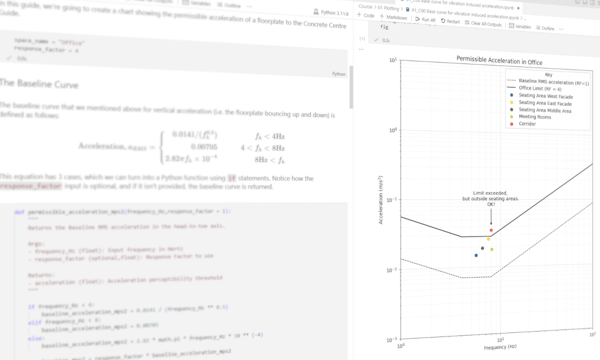
Module 2
Excel unleashed
We introduce the Pandas library to take spreadsheets to the next level while still using Excel. You’ll work with examples ranging from steel section catalogues to concrete test data to create useful tools that streamline your daily tasks.
🎥 Example: Using AI to assist processing Finite Element Data
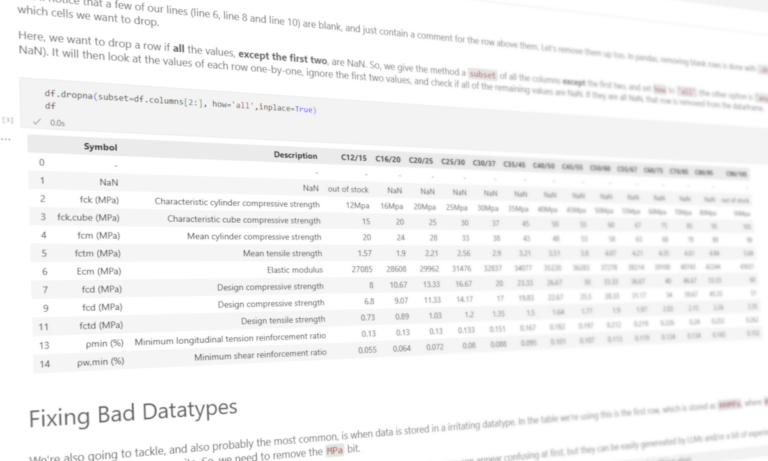
Module 3
Finite Element Models Through Text File Automation
Learn how to interact with files on your computer. You’ll read, modify, and create text files for finite element models.
We’ll show you how to easily change a finite element model while keeping everything transparent and organized.
🎥 Example: How to modify Finite Element Models with Python
🎥 Example: XML Editing with Python for FEM
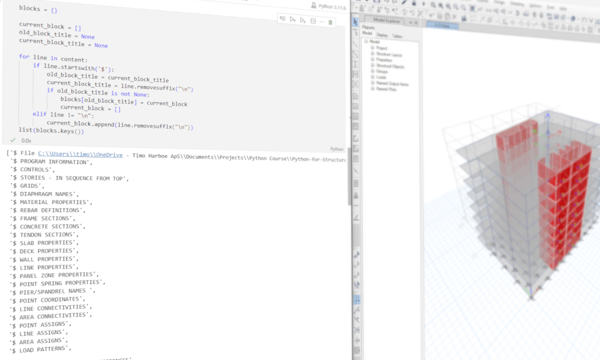
Module 4
Automate Finite Element Analysis Results Post-Processing
We return to Pandas to explore advanced features for creating templates to process the output from your finite element model. This module focuses on streamlining the process of extracting and analyzing finite element analysis results, helping you work faster and more efficiently.
🎥 Example: Compare Finite Element Models with Python
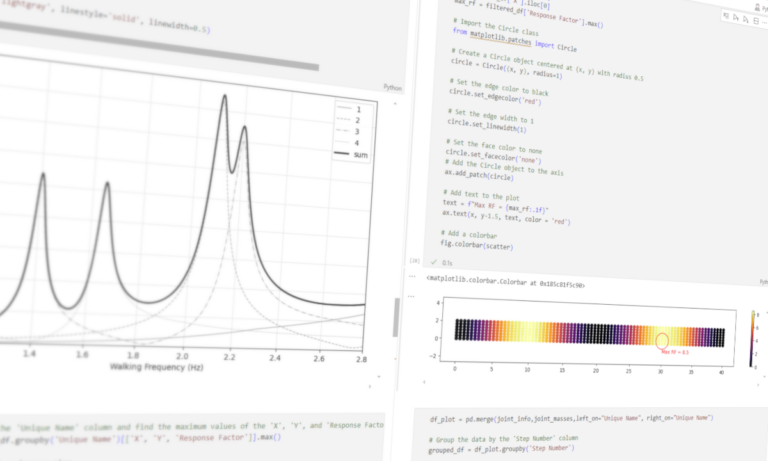
Meet the team

I’ve put together many of the lessons, exercises, and case studies for this course. I'm passionate about structural design and have worked on high-rise towers, lab spaces, and cultural venues.
I learnt Python during my degree at the University of Cambridge, and I have found Python to be an extremely powerful tool in nearly all aspects of structural engineering.
Now, I want to be part of helping our industry to use Python more effectively.

I'm skilled at breaking down complex ideas into engaging and enjoyable e-learning experiences. Using my analytical skills, I make tough concepts easy and fun for everyone. My approach is shaped by my Master’s degree in Education, ensuring effective and fun learning. I have supported Timo and Sam through various workshops to ensure the course meets e-learning best practices.
Amalie Langkjær E-Learning Specialist, MB & Partners
How you'll learn
- 100+ professionally edited short videos
- Interactive notebooks that cover everything in the course
- Multiple-choice quizzes to test your knowledge.
- Plenty of exercises to reinforce your learning.
- Larger projects to demonstrate how the skills you've learned can be applied to real-world problems
FAQ
Structural Engineers. The course is 100% centered around the daily tasks of a structural engineer. If you work with buildings, bridges, industrial structures or any other kind of load bearing structure this is for you.
399€ (+ VAT based on your location) for lifetime access
Basic structural engineering knowledge is required, but no programming experience is needed. The first module covers Python fundamentals.
The course has 5 modules, each divided into submodules with interactive notebooks, exercise sheets, and video explanations. Complete exercises, review summaries, and pass a quiz to proceed. Some modules end with larger example use cases.

The course is designed for 6 weeks, with 4-6 hours per week. Move steadily through the first module to build a strong Python foundation; then, complete the remaining four modules at your own pace.
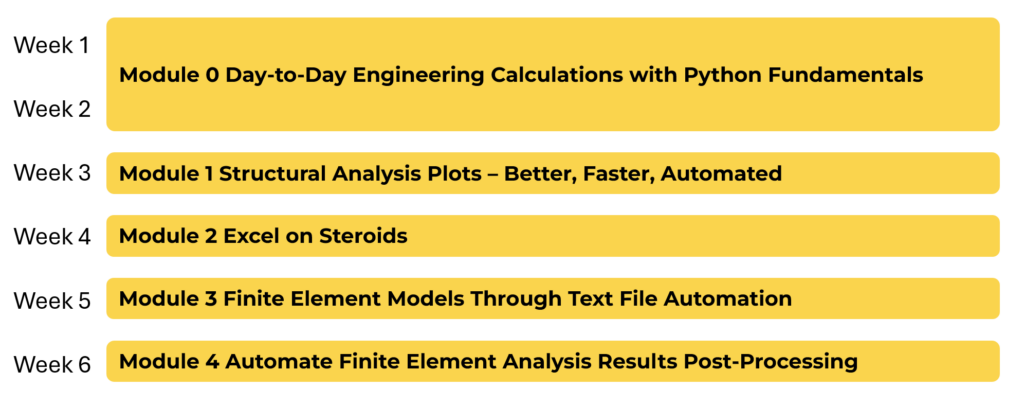
When you purchase access to the course, you receive:
- Interactive Notebooks: All course content, including comprehensive explanations and code, is provided in written format as interactive notebooks.
- Exercise Sheets & Quizzes: Practice your skills with exercise sheets and test your knowledge with quizzes.
- Video Lessons: Over 100 detailed, short, and professionally edited videos explaining the learning material.
- Lifetime Updates: If new material is added to the course, you’ll be notified and granted access.
- Community Forum: Join a forum where my partner and I are active, and engage in discussions with fellow students.
This is an on-demand, recorded course. Access it online, complete at your own pace, and enjoy lifetime access.
No, the course is designed to be independent of any specific software package.
A short registration window means more students are active at the same time, creating a more engaging community and it allows me to focus entirely on supporting current students.
No installation is required; the entire course can be completed online using Google Colab (free). You may choose to install Python locally as this will allow you to do everything that Python can do (also free).
Yes, enjoy a 30-day satisfaction guarantee with a full refund if you’re not satisfied. Terms and conditions apply.
Yes, and if you buy 7 licenses I'll give you an extra one for free.
Go to the checkout page for multiple licenses.
Also, feel free to contact me on timo@pythonforstructuralengineers.com for questions.
Please contact me on timo@pythonforstructuralengineers.com
We won’t be using Grasshopper in this course, but everything you learn can be applied directly in it. If you’re a Grasshopper user, learning Python is one of the best skills you can pick up!
What our students say
Instant application in daily work
This is a python course but entirely dedicated to structural engineering. That means it gives instant tools for daily work, as explained by the teachers, they are not lying! Although you won’t feel totally confident in the use of python after the course, in my experience, I had already managed to make some cool tools for my office, and have the necessary tools to continue learning and improving.
Best course for Python
This is the best course for learning Python for a beginner like me. Timo explains everything in a simple and easy-to-understand way. His teaching style is clear, friendly, and well-paced. The lessons are short but full of useful information. I like how he uses real examples to explain the concepts. It helps me understand how Python works in real life. The course structure is very organized.
A different perspective, essential to make a difference, even among engineers
Python is a tool that will become increasingly essential, because automating processes allows you to immediately focus on the design choices that matter, optimizing them.
If you want to make your profession more conscious, but also more cheerful, choose this course!
Great practical introduction to Python for structural engineers
I really enjoyed this course. It gave me a solid and comprehensive overview of the key Python tools used in structural engineering, which was exactly what I was looking for. The content is well-structured and clearly presented, making it easy to follow even for those with limited programming experience.
Engineer smarter, not harder.
This course stands out among industry-focused learning resources. The instructor’s hands-on expertise makes it worth every euro. While it begins with Python basics—great for a refresher—its true value lies in practical applications for structural engineering. Real-world case studies showcase Python’s concrete use in the field, making it an invaluable resource for professionals. 100% worth it.
Very Helpful
What is explained in the course is fully applicable. The application examples are very instructive.
We signed up Engineers in the last cohort! The feedback from them has been very positive and they have already build a suite of little tools to help solve real world problems!
The course every engineer should do
This should be a fundamental course for structural engineers.
Really thorough, goes deep into the material, but just enough that it does not get confusing.
The videos together with the notebooks are on point.
The main focus is on the matplotlib, pandas & os modules. One thing I expected more is a topic on numeric methods (numpy, scipy).
Congrats Timo & the Team for this fantastic course.
Practical, Insightful, and Highly Relevant.
The course is thoughtfully designed, providing a comprehensive introduction to Python with a strong focus on its applications in structural engineering. It covers essential fundamentals and delves into practical tools (Matplotlib, Pandas & OS). The exercises are crafted to simulate real engineering challenges, making the material highly relevant.
Thanks for creating such a valuable resource!
Automate for post processing.
The Python for Structural Engineering course offers a practical, hands-on approach to using Python for structural analysis, and automation for real-life structural post-processing problems.
Highly Recommend for Structural Engineers!
This is a very well-crafted, truly enjoyable course that exposed me to sheer potential of Python in enhancing and automating day-to-day workflows of structural engineers. It features a plethora of challenging exercises and quizzes to support with the learning – all supplemented by clear explanation. I recommend this course to anyone keen on expanding their skillsets and becoming more efficient.
Usefull, especially for structural engineers.
Great start to showcase how to use python in structural/civil engineering. However be aware that learning python takes months/years and will require fundamental work outside of the course. It is great, but it is no black magic. 🙂
Great!
Great for beginners in Python
Even though I had significant experience in Python I really liked the first modules. They are a great introduction and repetition of the basics.
I personally (as a Danish engineer) would have loved to see more practical examples specifically for Robot and FEM-Design. The two are by far the most common FE-software in Denmark.
Since this review, an additional example focusing on XML files (used by FEM-Design) has been added to the course.
This course will change your practice
The popularization of AI and the potential replacement of all professionals with it was a deep-seated fear I had before pursuing this course. Who would like to disappear into complete irrelevancy in the near future?
This course has allayed my fears allowing me to see AI as an assistant, improve my presentation, thinking and turnaround time without having to invest too much time in learning python.














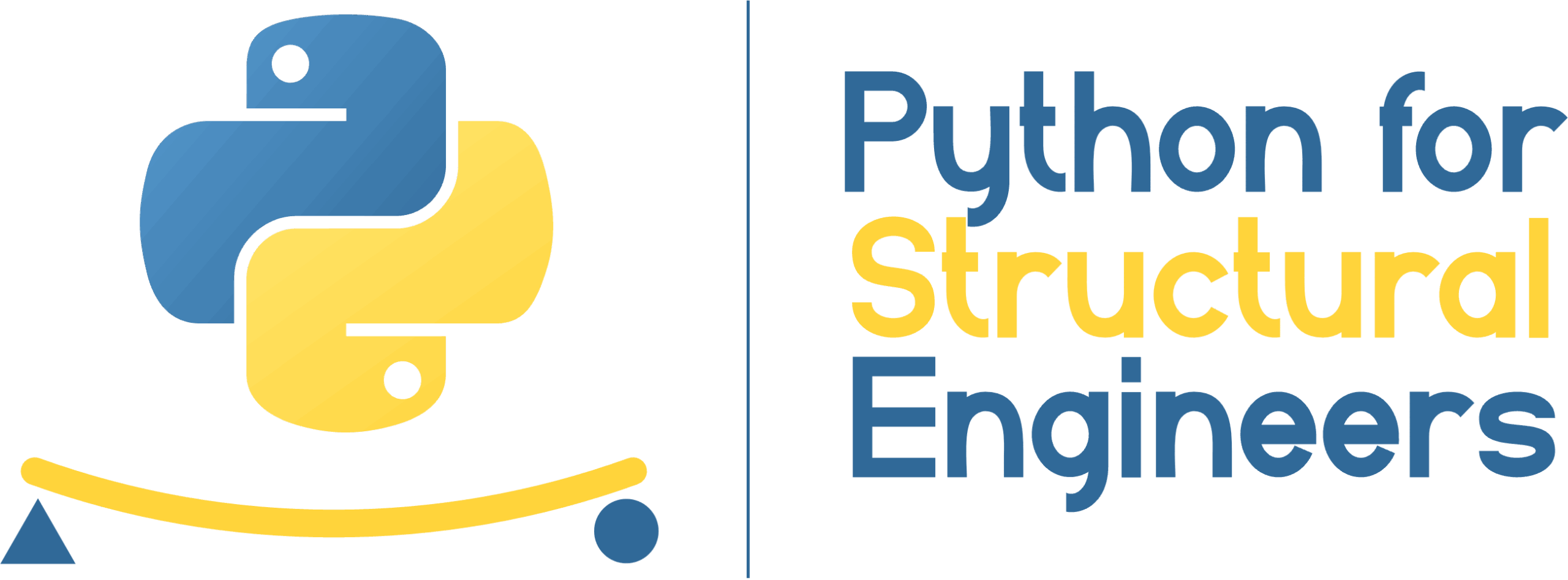
I have experience from Rambøll High Rise and Bjarke Ingels Group. I use Python daily and found it to be a game changer for the quality and speed I deliver. I love the creative problem-solving aspect of structural engineering and want to enable more engineers to unlock the potential of their computers.
Timo Harboe Zollner Structural Engineer